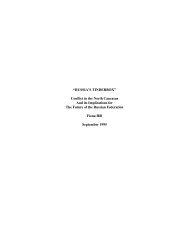The Heart of the Matter Valerie M. Hudson, - MIT Press Journals
The Heart of the Matter Valerie M. Hudson, - MIT Press Journals
The Heart of the Matter Valerie M. Hudson, - MIT Press Journals
You also want an ePaper? Increase the reach of your titles
YUMPU automatically turns print PDFs into web optimized ePapers that Google loves.
<strong>The</strong> <strong>Heart</strong> <strong>of</strong> <strong>the</strong> <strong>Matter</strong> 13<br />
<strong>the</strong> direction <strong>of</strong> one’s genotype. Changes in rates <strong>of</strong> survival and reproduction<br />
among individuals and kin groups will eventually change <strong>the</strong> genotype <strong>of</strong> <strong>the</strong><br />
overall population in this way.<br />
Evolutionary <strong>the</strong>ory suffers from two common misconceptions. <strong>The</strong> ªrst is<br />
that evolutionary predispositions are intractable. No evolutionary <strong>the</strong>orist believes<br />
this. Richard Dawkins explains, “It is perfectly possible to hold that<br />
genes exert a statistical inºuence on human behavior while at <strong>the</strong> same time<br />
believing that this inºuence can be modiªed, overridden, or reversed by o<strong>the</strong>r<br />
inºuences.” 13 <strong>The</strong> second misconception is that evolutionary <strong>the</strong>ory posits<br />
static and essential characteristics for males and females. This has been debunked<br />
as well. In debunking this myth, <strong>The</strong>odore Kemper notes, “Across <strong>the</strong><br />
spectrum <strong>of</strong> <strong>the</strong> social sciences, <strong>the</strong> results show that females are not essentially<br />
paciªc, retiring, unaggressive, lacking in motives and psychological need<br />
for power and dominance. While successful ideological socialization may persuade<br />
many women that this is true <strong>of</strong> <strong>the</strong>mselves, it is not biologically true.” 14<br />
Laying <strong>the</strong>se two misconceptions aside, we turn to <strong>the</strong> insights that evolutionary<br />
<strong>the</strong>ory can provide into <strong>the</strong> relationship between <strong>the</strong> physical security <strong>of</strong><br />
women and general traits and behaviors <strong>of</strong> human collectives, including<br />
nation-states.<br />
According to evolutionary <strong>the</strong>ory, human social structures are pr<strong>of</strong>oundly—<br />
even predominantly—shaped by natural selection for reproductive ªtness.<br />
Richard Alexander writes that culture can be seen as a “gigantic metaphorical<br />
extension <strong>of</strong> <strong>the</strong> reproductive system. ...[<strong>The</strong>re is] a reasonably close correspondence<br />
between <strong>the</strong> structure <strong>of</strong> culture and its usefulness to individuals in<br />
inclusive-ªtness-maximizing.” 15<br />
Sex differences across animal species produce a dazzling diversity <strong>of</strong> malefemale<br />
interaction. Richard Wrangham and Dale Peterson note, however, that<br />
out <strong>of</strong> “4,000 mammals and 10 millions or more o<strong>the</strong>r animal species,” only<br />
two species (humans and chimpanzees) live in “patrilineal, male-bonded communities<br />
wherein females routinely reduce risks <strong>of</strong> inbreeding by moving to<br />
neighboring groups [to mate within <strong>the</strong>se communities]. ...with [<strong>the</strong>se communities<br />
having] a system <strong>of</strong> intense, male-initiated territorial aggression, including<br />
lethal raiding into neighboring communities in search <strong>of</strong> vulnerable<br />
13. Richard Dawkins, <strong>The</strong> Selªsh Gene (Oxford: Oxford University <strong>Press</strong>, 1989), p. 331.<br />
14. <strong>The</strong>odore D. Kemper, Social Structure and Testosterone: Explorations <strong>of</strong> <strong>the</strong> Socio-Bio-Social Chain<br />
(New Brunswick, N.J.: Rutgers University <strong>Press</strong>, 1990), p. 138.<br />
15. Richard D. Alexander, “Evolution and Culture,” in Napoleon A. Chagnon and William Irons,<br />
eds., Evolutionary Biology and Human Social Behavior: An Anthropological Perspective (North Scituate,<br />
Mass.: Duxbury, 1979), pp. 59–78, at p. 77.
















